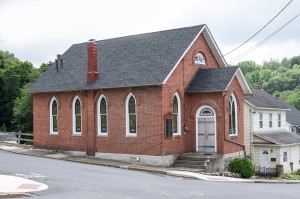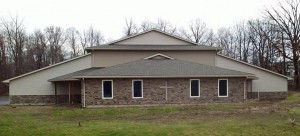Where we are as a church today is because of the vision of those who laid the foundation of the Church of the Nazarene in Bangor, Pennsylvania. In 1949, services began in the former Faith Primitive Methodist Church building on the corner of Miller and Northampton Streets in South Bangor.
Local Historian, Donald Jones says “I remember that Church. I was baptized there in 1922. It was the Primitive Methodist Church and I attended there until 1942 before I went into the service. My Mother was the Church Pianist and I sang solos there at the age of 9. ….Yes…. I Remember that Church. For many years the Church made pasties for a fund raiser and we sold them to the Julius Kayser Crown Hosiery plant on Lower South Main St.”

Photo by Ernie Dietz
North, South, West, and East Bangor are individual communities that had once planned to grow together as one large town. There were once 26 Slate quarries throughout the area which were the economic mainstay of these communities plus the towns of Pen Argyl and Wind Gap, which became known as the Slate Belt. The Bangor church, officially called Calvary Church of the Nazarene, started as a mission outreach of our Bethlehem Church of the Nazarene in Bethlehem, Pennsylvania. A satellite Sunday School Class began meeting in Bangor. In 1952, a formal charter was granted for the new congregation in May. There were 12 members with Rev. John Foltz (’51-’54) serving as pastor. Between the years of 1952-1973, the ministry was established under the direction of five pastors. They were Rev. Dale Hilkert, Rev. Charles Corley, Rev. Fred Henck, Rev. John Sluyter, and Rev. Elmer Guthrie.
On May 16, 1973, Pastor Kenneth Bean arrived in Bangor, along with his wife and then nine month old son Bryan, to begin a long term ministry here. Pastor Bean graduated from Olivet Nazarene College in 1969, and completed his M.Div degree from Nazarene Theological Seminary in 1973. Upon arrival, the first thing accomplished was re-establishing the nursery in the basement of the small two-story church building. Young families began coming and space constrictions caused the church to use the parsonage next door (on 32 Miller St.) for some youth Sunday School classes. Growth forced he church to utilize the living room of a church member across the street, as well as moving the adult class to the upstairs room of the Second Ward Fire Co. a half block away. In 1976, the church voted to purchase 5.81 acres of property on Bunny Trail in East Bangor for the purpose of erecting a new worship and education center. We thought we would be safe in taking a loan 5 years, but with sacrifice and God’s blessing, we were able to pay it off in just 2 years, three months. The building on our 150 Bunny Trail site was begun in 1979, and was completed and dedicated in April of 1980. In 1992, new seating was purchased for the worship area through individual pledges. The church driveway was paved through an individual gift in 1992. Due to the need for increased Sunday School space, we purchased two portable classrooms, one to house our Middler and Pre-teen classes and the other for our Teens. They have served us well in providing for these Sunday School classrooms over the years. Now that we are building, it’s going to be a blessing to have all of our Sunday School classes under one roof. Our youth presently lead our worship one time a month, we’ve added our young adults once a month as well. We are restructuring our Children’s Ministry to provide them with a biblical worldview. Strong supporting areas of ministry for us have been VBS, AWANA Kids Club, occasional Ladies Bible Study, First Place Weight Loss, Prayer Shawl Ministry, and small groups. We have been setting aside financing for our expansion fund for many years, we were able to break ground in November of 2014 and we hope to complete it on a cash basis. This will be a challenge for us, but we are committed to that.
The building on our 150 Bunny Trail site was begun in 1979, and was completed and dedicated in April of 1980. In 1992, new seating was purchased for the worship area through individual pledges. The church driveway was paved through an individual gift in 1992. Due to the need for increased Sunday School space, we purchased two portable classrooms, one to house our Middler and Pre-teen classes and the other for our Teens. They have served us well in providing for these Sunday School classrooms over the years. Now that we are building, it’s going to be a blessing to have all of our Sunday School classes under one roof. Our youth presently lead our worship one time a month, we’ve added our young adults once a month as well. We are restructuring our Children’s Ministry to provide them with a biblical worldview. Strong supporting areas of ministry for us have been VBS, AWANA Kids Club, occasional Ladies Bible Study, First Place Weight Loss, Prayer Shawl Ministry, and small groups. We have been setting aside financing for our expansion fund for many years, we were able to break ground in November of 2014 and we hope to complete it on a cash basis. This will be a challenge for us, but we are committed to that.
We continue strengthening our evangelism and discipleship ministries so God can use us to build His Kingdom and produce fruit that remains.